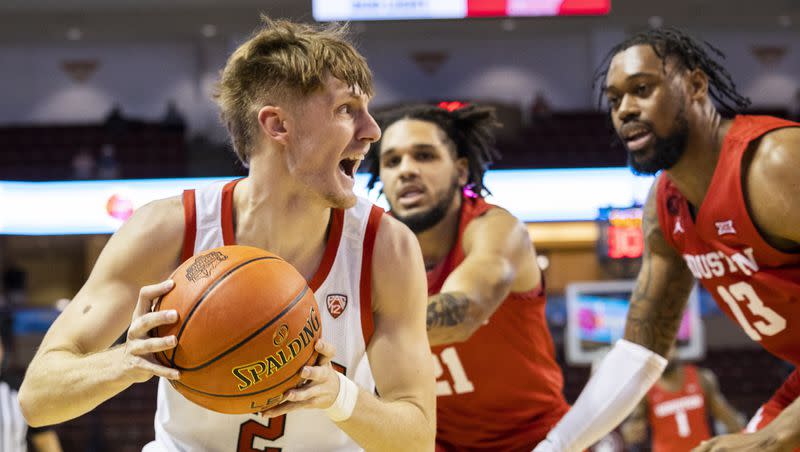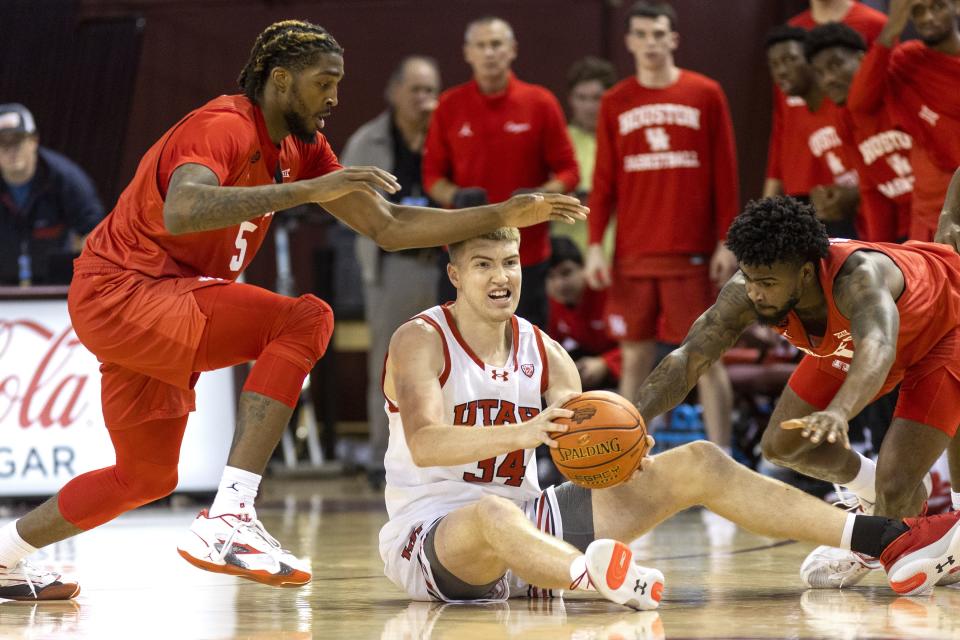What stands out about Utah basketball five games into the season

- Oops!Something went wrong.Please try again later.
Yes, the 2023-24 basketball season is just over two and a half weeks old but already an idea is forming about who Utah will be this year after the Runnin’ Utes recently finished up play in the Charleston Classic.
Here’s just a few things Utah can take away from that tournament — from things that are working well to others that need improving — in addition to what the Utes have shown through their first five games this season.
“We’re going to learn and grow from this thing. We’ve got to get healthy, our depth was tested, especially the last couple nights. Certainly I’m not discouraged and I’m excited about this group,” Utah coach Craig Smith told the Deseret News after the final day of the event Sunday.
Utah is going to be in most every game thanks to vets
Between the returning talent on this team and the transfers that were brought in, there is a good amount of game experience among the Runnin’ Utes’ main contributors early in the season.
Even though Utah went 1-2 at the Charleston Classic, there were moments when that veteran leadership shined through.
The most obvious was when Branden Carlson and Gabe Madsen posted career-highs in scoring — Carlson (31 points) in a win over Wake Forest, Madsen (29) in a 10-point loss to then-No. 6 Houston.
Utah also managed to fight back from double-digit deficits in the second half of each game it played in the Charleston Classic to either tie or lead in the second half.
Against Wake Forest, the Utes went on runs of 15-4 and 11-0 to eventually take control of the game.
Against ranked Houston, a 14-2 spurt briefly gave Utah a lead, before the Cougars quickly capitalized to regain control.
“I think the team just had belief in each other. It’s something we talk about a lot, just never losing the belief. That’s half the battle,” Madsen said of the Utes’ ability to rally against the Cougars — a sign of the early season belief inside the program.
Then against St. John’s, the Utes went on an 11-0 run to start the second half, briefly going ahead 54-52. During that run, veteran point guard Rollie Worster had a hand in several plays that led to Utah scores — he had two rebounds on defense where the Utes then scored on the other end twice, and he had back-to-back steals, with the second leading to a 3-pointer where Worster had the assist.
Related
In those runs, the primary faces of Smith’s third-year squad at Utah — Carlson, Madsen and Worster — each made key plays.
The hope is the Utes can complete the rally more often than they did in South Carolina.
“It’s a long, grinding season. The key is, you’ve got to be open to coaching and receptive and keep pushing it forward,” Smith said.
Utah still searching for consistent scoring outside Carlson and Madsen
As mentioned, Carlson and Madsen put up career-high scoring games at the Charleston Classic — for his efforts, Carlson was named the Pac-12 Player of the Week after averaging 23.3 points, 6.7 rebounds and 1.3 blocks per game during the tournament.
Outside of its top two scorers, though, the Runnin’ Utes will need to find other consistent scorers as well — someone who can pop off for a career game when Carlson and Madsen are bottled up by opposing defenses.
The most obvious candidate would be guard Cole Bajema, the transfer from Washington and the third guard in the starting lineup opposite Madsen and Worster.
Bajema, who is averaging 11.0 points per game through five contests, has scored in double figures in four games, though he went scoreless in the matchup against Houston when Madsen scored his career high.
Hunter Erickson is second on the team in assists (4.4 per game), but after shooting 42.1% from 3 at Salt Lake Community College last season, the senior transfer has made just 2 of 12 3-pointers early in the season.
Big man Lawson Lovering, the other frontcourt starter alongside Carlson, is averaging 9.6 points per game, and he has generally started games with early scores.
Somewhere, whether it’s from the other starters or someone coming off the bench, Utah will need to rely on other scorers as the season rolls on.
“You find out things that you are good at when you play really great teams and how you can be effective. Whether it’s scoring the ball or your personnel who can play in that kind of game, who’s ready and who’s not, and what works on the defensive end,” Smith said.
“On the flip side, you get exposed for what you are or what you aren’t. And then, we’ve got to get better at those things.”
The Utes played a short bench in Charleston
In the final two games of the Charleston Classic, the Utes primarily used a tight rotation that featured only three players who played significant minutes coming off the bench — that included Erickson, Ben Carlson and Luka Tarlac.
A big reason why is because of a pair of undisclosed injuries to sophomore Keba Keita and Wilguens Jr. Exacte.
Exacte has yet to play this season, and Keita did not play in the team’s last two games with an undisclosed injury — he played seven minutes against Wake Forest, about half the time he played in the season’s first two games.
The absence of both Exacte and Keita — two second-year players who earned minutes as freshmen and were expected to make bigger contributions this year — has kept the bench contributions lower, especially this past weekend.
“We’ve had a bit of misfortune that way, but that’s a part of sports,” Smith said. “... I’d like to get those guys back sooner than later, not sure what the timetable will be, so we’ll just have to see how these next eight days go (until Utah’s next game on Nov. 27).”
Against Houston, the Cougars held a 27-2 edge in bench points, and Smith mentioned after that game how Utah got “a little bit tired” after rallying to tie things against the top 10 program.
“We need more production out of our bench as a whole,” the coach said.
Plus, the team is still waiting on word whether two-time transfer guard Deivon Smith will receive a waiver from the NCAA to play this season.
Other bench players, like promising young wing Jake Wahlin and freshman guard Jayden Teat, simply are a bit too raw to reliably ask much beyond scattered minutes right now.
There’s lessons to take away from facing two defensive energy teams
The Utes’ offense wasn’t clicking as well when Utah faced two teams — Houston and St. John’s — that were adept at creating pressure on the defensive end.
The Cougars, who are second nationally in scoring defense (giving up 49.8 points per game), held Utah to 35.8% shooting and forced the Utes into 15 turnovers — Houston turned those miscues into 19 points.
Related
Utah actually got off to a strong start against Houston, taking an early 12-4 lead — the Utes made 4 of 5 field goals in the first five minutes, and included two 3-pointers and three assists.
Utah, though, shot 2 of 17 from the field over a nearly 14-minute stretch spanning the first and second halves — during that time, Houston stretched a 26-26 game into a 54-42 lead, as Utah had to rely on free-throw shooting to stay in the contest.
“We got a little jump shot happy, and that happens some nights — the speed of these guys, they can get you going quick and you start forcing stuff,” Smith said.
“Start of the second half when we started clawing back, we got the ball inside much more. We got them into foul trouble, we were in the double bonus with 12 minutes to go in the game. We just started throwing a lot more body blows, and we’ve got to play more like that.”
St. John’s led much of the game outside a pair of brief Utah one-possession leads and the Red Storm held Utah to 44.1% shooting.
St. John’s, using its defensive pressure, held a 16-5 edge in fast break points. The Red Storm also shot 53% for the game, and 50% (13 of 26) on 3-pointers.
“We have to find a way to still get those stops and contest a little bit more, force more misses, because there’s a very slim chance you have of winning when a team shoots over 50% from 3,” Branden Carlson said after the St. John’s game.
During the Utes’ opening pair of wins — blowout victories against overmatched Eastern Washington and UC Riverside — Utah paired a high energy defensive effort that limited chances for the opposition with an offense that fed off that defensive energy and created scoring opportunities.
In Charleston, the Utes saw in person that kind of defensive-minded approach working at an highly efficient level, and it caused them fits — it forced Utah to play out of rhythm offensively as the opposition set the pace.
Now, they have the chance to learn from that.
Finding ways to play more consistently on offense will be needed as Utah moves through its nonconference play and its Pac-12 action when the calendar turns.
“We know what we can do offensively when we play at our pace, but we’ve just got to be able to lock in for all 40 minutes defensively,” Carlson said.
What’s next for the Utes?
The Utes will leave the state just one more time before the end of December, as the final six games of their nonleague play are spread out over the next five weeks.
It will be interesting to note their preparation and consistency from game to game, with long stretches in between some contests.
Utah (3-2) plays its next game next Monday at Saint Mary’s, a program that played in the NCAA Tournament four of the past seven seasons but is off to a 2-3 start to this season.
That will be the Runnin’ Utes only true road game during nonconference play and despite the Gaels’ early-season struggles, that has the potential to be a Quad 1 game.
Following that, Utah will play Hawaii at the Delta Center on Nov. 30 and a trio of home games against in-state rivals Southern Utah (Dec. 5), BYU (Dec. 9) and Utah Valley (Dec. 16) during a week-and-a-half span.
The Utes will then host Bellarmine on Dec. 20, before taking a week and a half away from competition before opening Pac-12 play with a pair of weekend home games against Washington State (Dec. 29) and Washington (Dec. 31) to end the calendar year.
“We intentionally build a great schedule, and we’re excited about it. But we’ve got to learn from this, we’ve got to tighten things up and we’ve got to get better,” Smith said.


